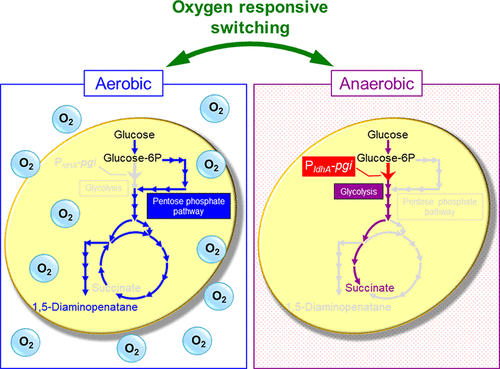当前位置:
X-MOL 学术
›
ACS Synth. Biol.
›
论文详情
Our official English website, www.x-mol.net, welcomes your
feedback! (Note: you will need to create a separate account there.)
Automatic Redirection of Carbon Flux between Glycolysis and Pentose Phosphate Pathway Using an Oxygen-Responsive Metabolic Switch in Corynebacterium glutamicum.
ACS Synthetic Biology ( IF 3.7 ) Pub Date : 2020-03-23 , DOI: 10.1021/acssynbio.9b00493 Shunsuke Kobayashi 1 , Hideo Kawaguchi 2 , Tomokazu Shirai 3 , Kazuaki Ninomiya 1, 4 , Kenji Takahashi 1 , Akihiko Kondo 2, 3 , Yota Tsuge 1, 4
ACS Synthetic Biology ( IF 3.7 ) Pub Date : 2020-03-23 , DOI: 10.1021/acssynbio.9b00493 Shunsuke Kobayashi 1 , Hideo Kawaguchi 2 , Tomokazu Shirai 3 , Kazuaki Ninomiya 1, 4 , Kenji Takahashi 1 , Akihiko Kondo 2, 3 , Yota Tsuge 1, 4
Affiliation

|
Controlling the carbon flux into a desired pathway is important for improving product yield in metabolic engineering. After entering a cell, glucose is channeled into glycolysis and the pentose phosphate pathway (PPP), which decreases the yield of target products whose synthesis relies on NADPH as a cofactor. Here, we demonstrate redirection of carbon flux into PPP under aerobic conditions in Corynebacterium glutamicum, achieved by replacing the promoter of glucose 6-phosphate isomerase gene (pgi) with an anaerobic-specific promoter of the lactate dehydrogenase gene (ldhA). The promoter replacement increased the split ratio of carbon flux into PPP from 39 to 83% under aerobic conditions. The titer, yield, and production rate of 1,5-diaminopentane, whose synthesis requires NADPH as a cofactor, were increased by 4.6-, 4.4-, and 2.6-fold, respectively. This is the largest improvement in the production of 1,5-diaminopentane or its precursor, lysine, reported to date. After aerobic cell growth, pgi expression was automatically induced under anaerobic conditions, altering the carbon flux from PPP to glycolysis, to produce succinate in a single metabolically engineered strain. Such an automatic redirection of metabolic pathway using an oxygen-responsive switch enables two-stage fermentation for efficient production of two different compounds by a single strain, potentially reducing the production costs and time for practical applications.
中文翻译:

在谷氨酸棒状杆菌中使用氧响应代谢开关自动调节糖酵解和戊糖磷酸途径之间的碳通量。
控制进入期望途径的碳通量对于提高代谢工程中的产物收率很重要。进入细胞后,葡萄糖被引导进入糖酵解和戊糖磷酸途径(PPP),从而降低了目标产物的产量,目标产物的合成依赖于NADPH作为辅因子。在这里,我们展示了在有氧条件下谷氨酸棒杆菌中碳通量重定向到PPP的方法,该方法是通过用乳酸脱氢酶基因(ldhA)的厌氧特异性启动子代替葡萄糖6磷酸异构酶基因(pgi)的启动子来实现的。在好氧条件下,促进剂的替换使进入PPP的碳通量的分配比从39%增加到83%。1,5-二氨基戊烷的滴定度,产率和产率(其合成需要NADPH作为辅因子)分别提高了4.6倍,4.4倍和2.6倍,分别。迄今为止,这是1,5-二氨基戊烷或其前体赖氨酸生产中的最大改进。有氧细胞生长后,在厌氧条件下会自动诱导pgi表达,从而将碳通量从PPP改变为糖酵解,从而在单个代谢工程菌株中产生琥珀酸。使用氧响应开关的这种代谢途径的自动重定向使两步发酵能够通过单个菌株有效地生产两种不同的化合物,从而潜在地降低了生产成本和实际应用的时间。改变从PPP到糖酵解的碳通量,以在单个代谢工程菌株中产生琥珀酸酯。使用氧响应开关的这种代谢途径的自动重定向使两步发酵能够通过单个菌株有效地生产两种不同的化合物,从而潜在地降低了生产成本和实际应用的时间。改变从PPP到糖酵解的碳通量,以在单个代谢工程菌株中产生琥珀酸酯。使用氧响应开关的这种代谢途径的自动重定向使两步发酵能够通过单个菌株有效地生产两种不同的化合物,从而潜在地降低了生产成本和实际应用的时间。
更新日期:2020-04-23
中文翻译:

在谷氨酸棒状杆菌中使用氧响应代谢开关自动调节糖酵解和戊糖磷酸途径之间的碳通量。
控制进入期望途径的碳通量对于提高代谢工程中的产物收率很重要。进入细胞后,葡萄糖被引导进入糖酵解和戊糖磷酸途径(PPP),从而降低了目标产物的产量,目标产物的合成依赖于NADPH作为辅因子。在这里,我们展示了在有氧条件下谷氨酸棒杆菌中碳通量重定向到PPP的方法,该方法是通过用乳酸脱氢酶基因(ldhA)的厌氧特异性启动子代替葡萄糖6磷酸异构酶基因(pgi)的启动子来实现的。在好氧条件下,促进剂的替换使进入PPP的碳通量的分配比从39%增加到83%。1,5-二氨基戊烷的滴定度,产率和产率(其合成需要NADPH作为辅因子)分别提高了4.6倍,4.4倍和2.6倍,分别。迄今为止,这是1,5-二氨基戊烷或其前体赖氨酸生产中的最大改进。有氧细胞生长后,在厌氧条件下会自动诱导pgi表达,从而将碳通量从PPP改变为糖酵解,从而在单个代谢工程菌株中产生琥珀酸。使用氧响应开关的这种代谢途径的自动重定向使两步发酵能够通过单个菌株有效地生产两种不同的化合物,从而潜在地降低了生产成本和实际应用的时间。改变从PPP到糖酵解的碳通量,以在单个代谢工程菌株中产生琥珀酸酯。使用氧响应开关的这种代谢途径的自动重定向使两步发酵能够通过单个菌株有效地生产两种不同的化合物,从而潜在地降低了生产成本和实际应用的时间。改变从PPP到糖酵解的碳通量,以在单个代谢工程菌株中产生琥珀酸酯。使用氧响应开关的这种代谢途径的自动重定向使两步发酵能够通过单个菌株有效地生产两种不同的化合物,从而潜在地降低了生产成本和实际应用的时间。











































 京公网安备 11010802027423号
京公网安备 11010802027423号